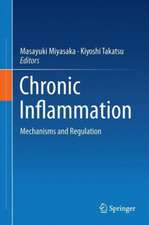Multiple Sclerosis Immunology: A Foundation for Current and Future Treatments
Editat de Takashi Yamamura, Bruno Granen Limba Engleză Paperback – 23 aug 2016
| Toate formatele și edițiile | Preț | Express |
|---|---|---|
| Paperback (1) | 788.88 lei 43-57 zile | |
| Springer – 23 aug 2016 | 788.88 lei 43-57 zile | |
| Hardback (1) | 1111.46 lei 43-57 zile | |
| Springer – 14 sep 2013 | 1111.46 lei 43-57 zile |
Preț: 788.88 lei
Preț vechi: 830.39 lei
-5% Nou
Puncte Express: 1183
Preț estimativ în valută:
150.97€ • 156.66$ • 126.18£
150.97€ • 156.66$ • 126.18£
Carte tipărită la comandă
Livrare economică 17-31 martie
Preluare comenzi: 021 569.72.76
Specificații
ISBN-13: 9781493942015
ISBN-10: 1493942018
Pagini: 478
Ilustrații: XVII, 461 p. 46 illus., 38 illus. in color.
Dimensiuni: 155 x 235 x 25 mm
Greutate: 0.67 kg
Ediția:Softcover reprint of the original 1st ed. 2013
Editura: Springer
Colecția Springer
Locul publicării:New York, NY, United States
ISBN-10: 1493942018
Pagini: 478
Ilustrații: XVII, 461 p. 46 illus., 38 illus. in color.
Dimensiuni: 155 x 235 x 25 mm
Greutate: 0.67 kg
Ediția:Softcover reprint of the original 1st ed. 2013
Editura: Springer
Colecția Springer
Locul publicării:New York, NY, United States
Cuprins
Th17 cells in autoimmune inflammation and demyelination in the central nervous system.- Regulatory T cells in MS.- T-bet: A critical regulator of encephalitogenic T Cells.- Antigen-presenting cells in the Central Nervous System.- The role of B cells in multiple sclerosis.- Diet, gut flora and multiple sclerosis: current research and future perspectives.- GM-CSF in autoimmune inflammation of the central nervous system.- The role of Toll-like receptors in multiple sclerosis and experimental autoimmune encephalomyelitis.- Macrophages and microglia in experimental autoimmune encephalomyelitis and multiple sclerosis.- Genetics of multiple sclerosis.- Gene expression profiling and pathway analysis for identification of molecular targets in MS.- Systems biology for the study of multiple sclerosis.- Checkpoints in the development of pathogenic and regulatory T cells in Experimental Autoimmune Encephalomyelitis—a basis for current future interventions in MS.- Modeling MS in non-human primates.- A novel concept of treatment in MS: targeting both oligodendrocyte death and inflammatory processes by inhibiting poly (ADP-Ribose) polymerase.- Association of MS with other autoimmune diseases.- Current and future treatments of Multiple Sclerosis.- Targeting CD52 for the treatment of Multiple Sclerosis.- Haematopoietic stem cells for the treatment of MS.- Mesenchymal stem cells for the treatment of Multiple Sclerosis.
Textul de pe ultima copertă
The availability of powerful genome-wide association study technology, during the last five years, has shown that most of the “new” MS susceptibility loci are immune-response genes. It is clear that there is much novelty in the field of MS immunology, which has served as an impetus to invest in new therapies. Notably, most if not all of these are immunotherapies. Even the equally exciting field of cell-based therapies and neuro-regeneration may well rely on cells or growth factors that are no less immunomodulators than restorative of myelin and neural cell function. Multiple Sclerosis Immunology looks at MS immunology as the basis for the present and—even more—the future of treatments for this complex autoimmune condition. Both editors are immunologists, as well as clinical neurologists, and appreciate the importance of a sustained dialogue between basic and clinical scientists to ensure that “translation” is real and not just virtual.
Caracteristici
Will complement existing works and be comprehensive Will include testimony of an immunobiologist who is also a patient Editors are both immunologists and clinicians, so will offer a complete perspective Includes supplementary material: sn.pub/extras





























